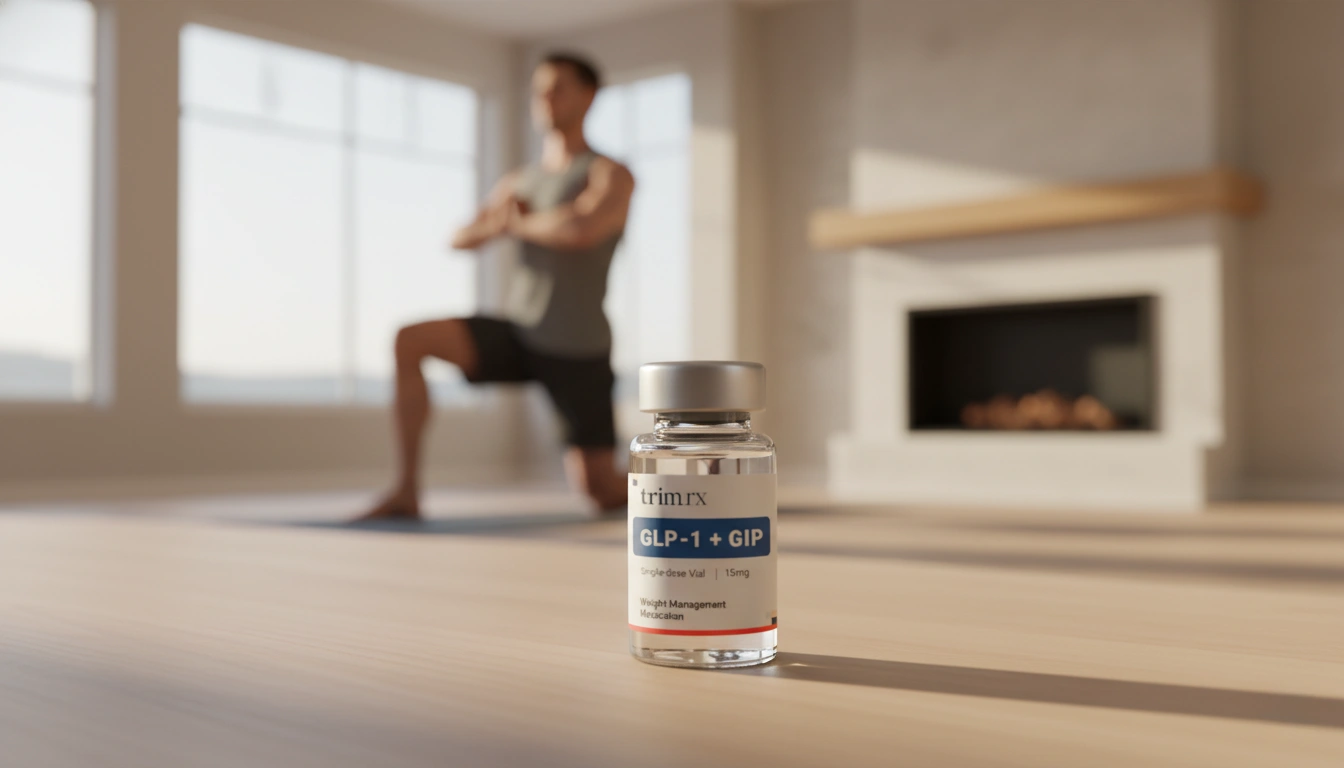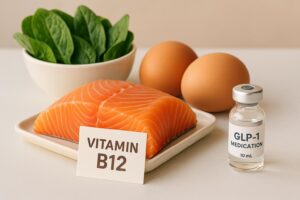Can You Boost GLP-1 Naturally Through Dietary Choices?

Is it possible to leverage the power of our diet to influence hormones in our body? Imagine a hormone that plays a pivotal role in regulating blood sugar and appetite—this is where Glucagon-Like Peptide-1 (GLP-1) comes into play. GLP-1 is a naturally occurring hormone produced in the gut that is released when we eat, and its functions are crucial for metabolic health. Given the increasing prevalence of obesity and type 2 diabetes, understanding how to naturally boost GLP-1 levels can empower us in our weight loss and health journeys.
At TrimRx, we recognize the importance of personalized and science-backed approaches to weight management. In this blog post, we will explore how dietary choices can enhance GLP-1 levels, the role of gut health in this process, and the broader implications for weight loss and overall well-being.
Introduction
Did you know that the foods you eat can actually influence a hormone that helps regulate your appetite and blood sugar levels? GLP-1 is a key player in our body’s metabolic processes, and it plays several roles including stimulating insulin release, slowing down digestion, and signaling to our brains when we’re full. As we explore the means by which we can boost GLP-1 naturally, we will delve into the dietary components that can help support its release, the significance of gut health, and how these elements can contribute to sustainable weight loss.
This blog post aims to provide you with a comprehensive understanding of GLP-1, its functions, and actionable strategies for naturally enhancing its levels through dietary choices. By the end of this article, you will have a clear insight into the potential of food as a tool for weight management, while also appreciating the connection between gut health and hormone regulation.
Together, we’ll navigate through the scientific underpinnings of GLP-1, discuss the impact of certain foods, and highlight lifestyle changes that can support your weight loss journey. We hope to empower you with knowledge that can lead to healthier habits and, ultimately, a more balanced lifestyle.
Understanding GLP-1: What is it and Why Does it Matter?
GLP-1 is a hormone secreted by the intestinal cells in response to food intake. Its primary functions involve:
- Stimulating Insulin Release: GLP-1 helps regulate blood sugar levels by promoting the secretion of insulin when glucose levels rise after meals.
- Slowing Gastric Emptying: By slowing the movement of food from the stomach into the intestines, GLP-1 helps prevent rapid spikes in blood sugar.
- Reducing Appetite: GLP-1 acts on the brain to promote feelings of fullness, which can decrease overall food intake.
Given its multifaceted role, GLP-1 has garnered attention as a target for weight management and diabetes treatment. Prescription medications like semaglutide (Ozempic, Wegovy) and tirzepatide (Mounjaro, Zepbound) imitate the action of GLP-1, helping to achieve significant weight loss and improved glycemic control.
However, while these medications can be effective, many individuals are interested in exploring natural ways to enhance GLP-1 production. Fortunately, research suggests that certain dietary components can indeed increase GLP-1 levels.
Foods That Can Boost GLP-1 Levels
Certain foods have been shown to stimulate the release of GLP-1, contributing to feelings of satiety and helping maintain balanced blood sugar levels. Here are some key food groups and specific examples that can help boost GLP-1 naturally:
1. High-Fiber Foods
Fiber plays a crucial role in stimulating GLP-1 secretion. It is fermented by gut bacteria, producing short-chain fatty acids (SCFAs) that encourage GLP-1 release. Incorporating a variety of fiber-rich foods can be beneficial:
- Whole Grains: Foods like oats, barley, and quinoa are excellent sources of soluble fiber, which can promote GLP-1 release.
- Fruits and Vegetables: High-fiber options such as apples, pears, broccoli, and Brussels sprouts can help support GLP-1 production while also providing essential vitamins and minerals.
2. Healthy Fats
Monounsaturated and polyunsaturated fats can also enhance GLP-1 secretion. Foods rich in healthy fats include:
- Avocados: Their high fiber and healthy fat content makes avocados a great choice for promoting GLP-1.
- Nuts and Seeds: Almonds, walnuts, and chia seeds are not only nutritious but also promote a feeling of fullness, aiding in weight management.
3. Protein Sources
Certain proteins are linked to increased GLP-1 levels. Including a variety of protein sources in your diet can help:
- Eggs: High in protein and healthy fats, eggs have been shown to enhance GLP-1 secretion.
- Lean Meats and Fish: Foods like chicken, turkey, and fatty fish provide essential nutrients and help with satiety.
4. Fermented Foods
Probiotics found in fermented foods can positively influence gut health, which may further enhance GLP-1 production. Consider:
- Yogurt and Kefir: These dairy products contain beneficial bacteria that can support a healthy gut microbiome.
- Sauerkraut and Kimchi: Fermented vegetables are not only rich in probiotics but also fiber, making them a double whammy for boosting GLP-1.
The Role of Gut Health in GLP-1 Production
A healthy gut microbiome is essential for the optimal production of GLP-1. The trillions of microbes residing in our intestines play a significant role in digestion, metabolism, and hormone regulation. Here’s how gut health influences GLP-1 levels:
1. Short-Chain Fatty Acids (SCFAs)
When we consume fiber, gut bacteria ferment it into SCFAs, which directly stimulate GLP-1 release. High-fiber foods can lead to increased SCFA production, thus promoting GLP-1 levels.
2. Diversity of Gut Microbes
Research indicates that individuals with a diverse gut microbiome tend to have better metabolic health. A diet rich in various fruits, vegetables, whole grains, and fermented foods can enhance microbial diversity, which is beneficial for GLP-1 production.
3. Probiotics and Prebiotics
Incorporating probiotics and prebiotics into your diet can support gut health. Prebiotics, such as inulin and resistant starch, feed beneficial bacteria, while probiotics introduce live bacteria that can enhance gut function. This balanced approach can lead to improved GLP-1 secretion.
Lifestyle Changes to Naturally Boost GLP-1
In addition to dietary choices, certain lifestyle changes can also enhance GLP-1 levels. Here are some strategies to consider:
1. Regular Physical Activity
Exercise has been shown to increase GLP-1 levels. Engaging in regular aerobic and resistance training can improve insulin sensitivity and promote hormone regulation. Aim for at least 150 minutes of moderate-intensity exercise each week.
2. Adequate Sleep
Quality sleep is essential for overall health and hormone regulation. Poor sleep can negatively affect appetite hormones, including GLP-1. Strive for 7-9 hours of restful sleep per night to support metabolic health.
3. Stress Management
Chronic stress can disrupt hormonal balance, including GLP-1 levels. Incorporating stress-reducing practices such as mindfulness, meditation, or yoga can support overall well-being and help maintain healthy hormone levels.
Conclusion
Boosting GLP-1 levels naturally is not only feasible but also beneficial for those looking to manage their weight and improve their metabolic health. By making informed dietary choices, embracing a diverse range of foods, and adopting healthy lifestyle practices, we can support our bodies in producing this vital hormone.
At TrimRx, we believe in the power of personalized, medically supervised weight loss solutions that prioritize health and wellness. While our programs can assist in your weight loss journey, understanding the role of GLP-1 and how to naturally enhance its levels can empower you to take charge of your health.
As you consider your approach to weight management, we invite you to explore our free assessment quiz to better understand your eligibility for our personalized weight loss programs. Together, we can work towards achieving your health goals.
FAQ
What is GLP-1 and why is it important?
GLP-1 is a hormone produced in the gut that plays a crucial role in regulating blood sugar levels and appetite. It promotes insulin release, slows digestion, and signals fullness, making it important for weight management and metabolic health.
How can I increase GLP-1 levels naturally?
You can boost GLP-1 levels by incorporating high-fiber foods, healthy fats, lean proteins, and fermented foods into your diet. Regular physical activity, adequate sleep, and stress management can also support GLP-1 production.
Are there specific foods that are particularly good for increasing GLP-1?
Yes, foods such as whole grains (oats, barley), fruits (apples, pears), vegetables (broccoli, Brussels sprouts), healthy fats (avocados, nuts), and high-protein foods (eggs, lean meats) can help increase GLP-1 levels.
Can supplements help boost GLP-1 levels?
While some supplements claim to increase GLP-1 levels, it is best to focus on whole foods and a healthy diet. Always consult with a healthcare provider before starting any supplements.
How does gut health affect GLP-1 production?
A healthy gut microbiome enhances GLP-1 production by fermenting fiber into short-chain fatty acids, which stimulate GLP-1 release. A diverse diet rich in fiber and probiotics can support gut health and GLP-1 levels.
By understanding the relationship between diet, gut health, and GLP-1, we can make empowered choices that not only support weight loss but also promote overall health and wellness.

Transforming Lives, One Step at a Time
Keep reading
Vitamin B12 and GLP-1 Medications: What to Know
GLP-1 medications can lower B12 absorption and intake; learn symptoms, food sources, supplement options, and how to monitor levels.
Semaglutide Injection Site Reactions: What To Know
Learn why semaglutide injections can cause redness, swelling or nodules, how to prevent and treat them, and when to seek medical care.
TrimRx vs Friday’s
Compare TrimRx and Friday’s telehealth GLP-1 weight-loss programs: pricing, medical support, coaching, delivery, and which fits your needs.



